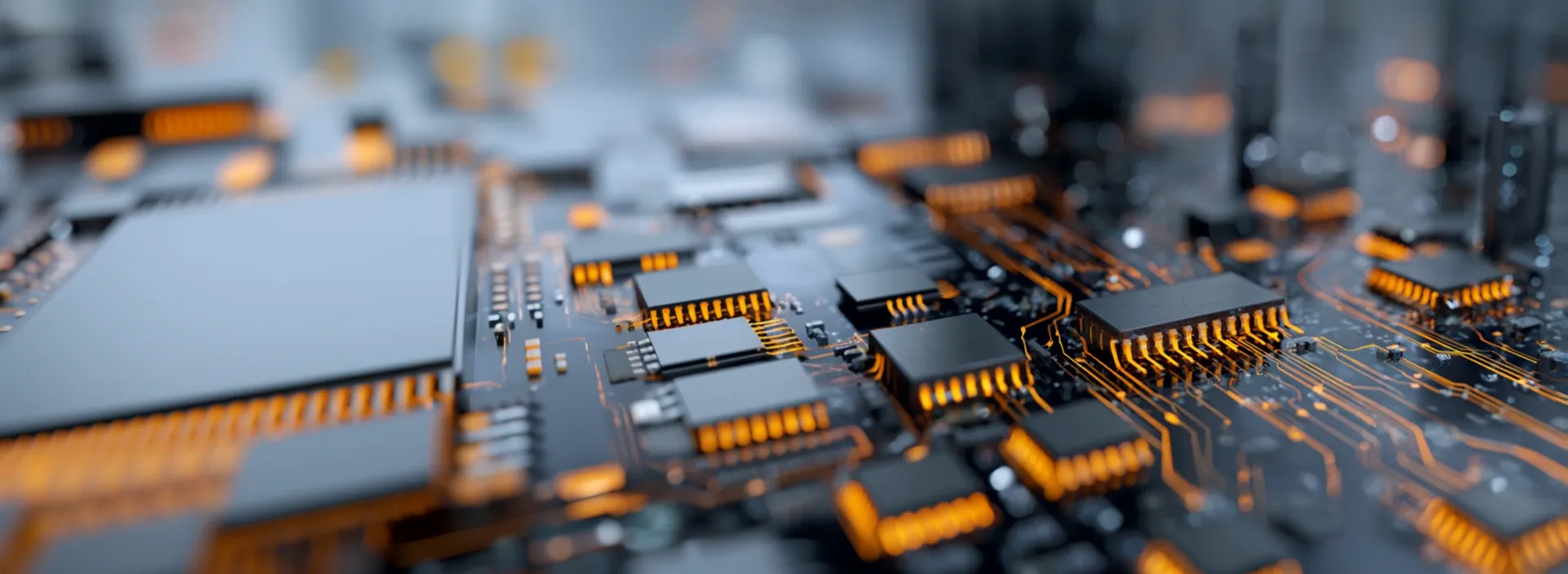Some embedded software trends, once new and hyped, like using Zephyr, have now become a staple for most embedded development projects. The reason? Its growing list of board-support packages and backing from Intel, NXP, Nordic, ST, and more.
Other trends, like the use of Sigfox, have now become history for different reasons: failing to raise new capital, declining adoption rate, etc. Sigfox's bankruptcy has caused its adopters to react quickly to the change, entailing extra spending to ensure the availability of the dependent processes.
With tech trends waxing and waning, how can you increase your chances of investing in the ones that're here to stay? This article explores established and emerging embedded software engineering trends that have the potential to remain there for the long run. It also features insights from Mykhaylo Kohut, an Embedded Solutions Architect at N-iX. Let's start by reviewing the market and tech context of 2025 and upcoming 2026.
What shapes the current trends in embedded systems?
Tech trends become staples when three things happen:
- The technology matures;
- The ecosystem has been built up around it;
- The cost-benefit case becomes obvious.
The same is true for embedded software trends. However, there are other factors that influence the embedded trends. Let's take a look at some examples.
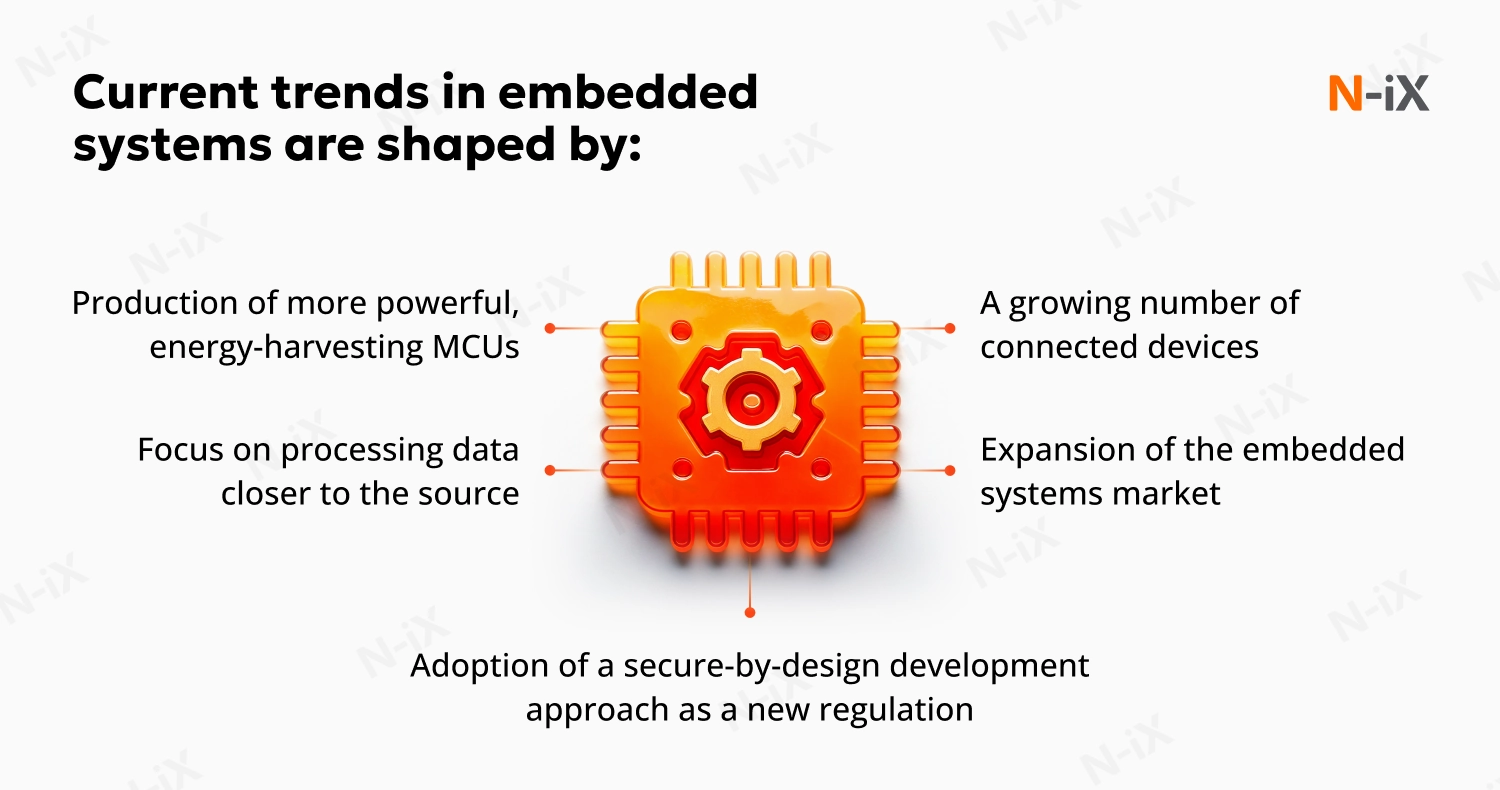
A growing number of connected devices
According to IoT Analytics' "State of IoT 2024", the number is expected to double, from 21.5B devices in 2025 to 41.1B in 2030 [1]. Since embedded services are often needed for connected device engineering and wearable app development, an increasing number of connected devices will entail expanding the embedded system market. According to Precedence Research, the embedded systems market will grow from $178.15B in 2024 to $283.9B by 2034 [2].
For businesses, it means a tight competition for components and customers, accelerating the need for unique products and features development. At the same time, the more devices means more attack surfaces and interoperability demands. It stimulates the businesses to increase security, compliance, and long-term maintenance costs.
Expansion of the embedded systems market
As more manufacturers add controllers to every product, they'll need more skilled engineers to handle their integration and maintenance. It will strain an already limited pool of embedded engineers. As a result, it will accelerate the adoption of AI-assisted coding, DevSecOps pipelines, and model-based design tools.
This, in turn, will change the approach to the embedded development team's makeup. The companies will now need ML specialists, DevSecOps engineers, and system-level architects alongside traditional firmware developers.
Adoption of a secure-by-design development approach as a new regulation
In December 2024, the EU officially adopted the Cyber Resilience Act, ensuring secure development and maintenance of hardware and software products [3]. After a 36-month transition period, manufacturers intending to get their products CE-certified for selling on the EU market will be obliged to comply with the regulations regarding cybersecurity risk assessment, secure development practices, vulnerability assessment, and patching.
Focus on processing data closer to the source
The need to decrease latency in processing real-time data forces companies to create strategies to adopt more edge computing solutions. According to the International Data Corporation, global spending on edge computing solutions will increase from $261B in 2025 to a projected $380B by 2028 [4].
This tendency propels the shift from cloud data centres to on-site devices and gateways. As a result, the companies should focus on funding distributed hardware, developing skills for managing many micro-data-centres, and redesigning security models to protect intelligence that no longer lives in a single location.
Production of more powerful, energy-harvesting MCUs
Emerging technologies now allow embedded systems devices to draw energy from their environment. Energy-harvesting devices integrate a high-performance core with on-chip power-management circuitry for solar, RF, thermal, or vibration harvesting. This enables integrating more power-consuming technologies, like lightweight AI, right at the edge. Wider adoption of low-energy MCUs pushed embedded teams to code for ultra-low power budgets, use energy-aware toolchains, and rethink security updates that must last for a device's entire field life.
These and other events are forming the future of embedded systems trends. Here's what it will look like.
Top 9 trends in embedded software engineering
Embedded software trends require careful consideration of whether the popular tool or framework will fit your case, serve your needs, or make any other difference worth investing in. Here are a few things to consider before embarking on the trendy journey:
- End goal of the adoption of the tool, technology, or framework;
- Power, energy consumption, and configuration of the hardware that would be transforming;
- Current tech ecosystem;
- Legal requirements for embedded solutions and tools;
- The cost of communication and resources, especially for AI projects.
Once you have these things figured out, you'll make a more informed decision about adopting or transforming your embedded development processes. The following is the list of current and emerging trends in embedded systems to consider if you want to stay in the know.
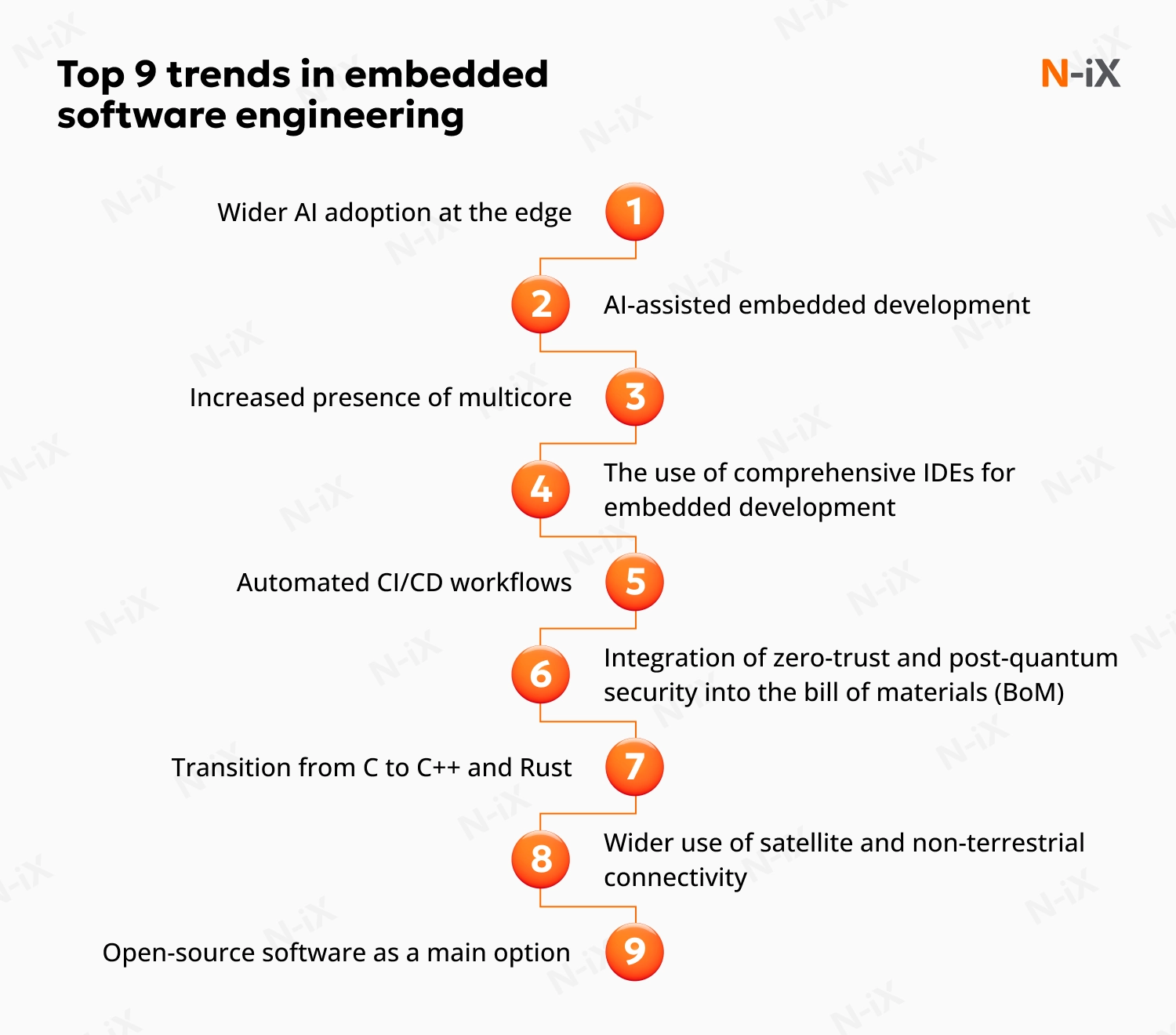
1. Wider AI adoption at the edge
Adopting AI at the edge prompts firmware development teams to treat microcontrollers as miniature inference engines, not just data loggers. Instead of streaming raw engine data to the cloud, engineers can now equip MCUs or MPUs with a small on-device AI model that sends a warning only when the pattern looks abnormal.
Results: For the business, it means lower bandwidth and cloud expenses and fewer costly production bottlenecks due to faster anomaly detection. It also opens new revenue opportunities, such as offering value-added predictive-maintenance features or tiered analytics services to customers.
Expert's tips: AI demands resources and embedded software tailored for AI data processing. You should choose solutions optimized for AI and decide where the data processing will run. In addition, your workflows should become AI-centric, where teams must master data curation, model compression, and on-device validation alongside traditional driver code.
2. AI-assisted embedded development
One of the trends in embedded system development that springs from the wider adoption of Artificial Intelligence is AI-assisted embedded development. The idea is to replace manually written boilerplate code, configuration files, and test scripts with on-demand, model-generated code and tests.
A developer types a plain-language prompt, and the tool produces fully formed driver code, OS tasks, and a matching unit test in seconds. The same engine runs static checks to spot race conditions or stack-overflow risks long before the firmware hits the hardware bench.
Results: It helps businesses shorten development and validation time from weeks to hours, reducing labour cost and improving time-to-market. Freed from repetitive tasks, engineers can focus on innovation and differentiation, helping the company launch more features.
Expert's tips: AI is a tool that still makes mistakes. So, if you use its help, you need to check every code manually, which can be time-consuming. Plus, you must always ensure that AI-written code will work with legacy code. Sometimes, integration and communication issues take up much time, and manual intervention is needed to resolve them. Privacy and security are other things to consider, especially if you need to share the model already written as a part of the prompt.
Explore further: Offshore embedded software development: Success stories
Discover how AI is transforming software development—get the guide now!
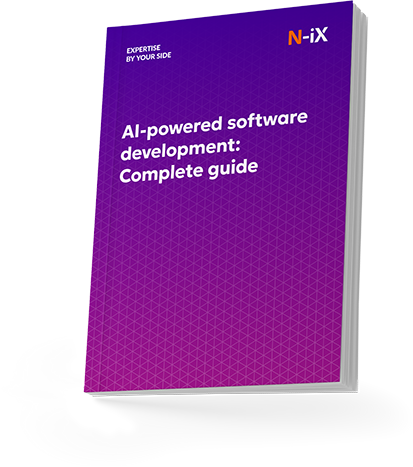

Success!

3. Increased presence of multicore processors
Embedded software once ran on a single core, with one scheduler allocated time for every task. Today's dual- and quad-core MCUs let designers keep real-time control on one core while offloading other tasks to other cores, allowing simultaneous processing.
Results: It allows for higher throughput and tighter real-time guarantees. Multicore MCUs let a single board handle real-time control and high-level tasks in parallel, boosting performance and consolidating hardware. However, they also introduce new complexities. The developers must adopt SMP-ready OSes, inter-core messaging frameworks, and race-condition analysis tools to keep those gains reliable.
Expert's tips: Multicore is expensive not only in terms of the processor costs but also in terms of the resources and complexities regarding the management of energy, memory, etc. You should assess whether switching to multicore architecture is something you need. The transition makes sense if multicore-based solutions will be used for time-critical and costly tasks (e.g., adopting AI on the edge).
4. Wider use of satellite and non-terrestrial connectivity
Until recently, remote devices either saved data locally or used bulky, costly satellite gear, and firmware rarely handled latencies beyond 50 ms RRT. Plug-in satellite modules now make Low-Earth-Orbit (LEO) connectivity as simple as adding a cellular modem, so that data can stream from anywhere.
Results: Continuous telemetry from ships, mines, and pipelines eliminates on-site data collection and the blind spots that may lead to costly downtime. It allows businesses to extend services to any geography and meet real-time reporting requirements.
Expert's tips: You should assess whether it's applicable to the environment. If satellite is the only connectivity option, embedded teams must design for higher latency, burst-current power peaks, and dual-mode connectivity logic to make that global link both reliable and energy-efficient.
5. Increased use of memory-safe languages
Embedded code bases built in C/C++ are prone to buffer overruns and pointer errors, so a single missed check can crash a product in the field. New toolchains for Rust and Ada/SPARK now let developers write driver and application code with the compiler automatically tracking those classes of defects, relegating C to only the tiny, performance-critical routines that need it.
Results: By removing whole categories of runtime faults up front, companies cut the time and money spent on CERT/MISRA audits, emergency patches, and warranty claims. Projects clear security reviews faster, brand trust improves, and engineering hours shift from firefighting to feature innovation, accelerating releases without expanding headcount.
Expert's tips: C gives embedded developers low-level control of hardware. The downside is that there are no automated workflows, and every bug should be monitored and fixed manually. Memory-safe languages allow developers to monitor energy and memory consumption automatically, at the expense of resources. For the company, it will translate either into developers' wages or more powerful hardware costs. So you need to choose whether it's more important to have complete control over the code or to detect errors automatically.
6. Integration of zero-trust and post-quantum security into the bill of materials (BoM)
Until now, security was often an afterthought. Upcoming zero-trust and post-quantum rules change the game: procurement sheets now specify built-in roots of trust and secure elements alongside processors and memory, baking protection into the hardware from day one.
Results: Security becomes a budgeted, measured part of the hardware design. This will reduce retrofit costs and help future-proof products against today's lateral movement attacks and tomorrow's threats.
Expert's tips: If your company deals with production, you should include security chips at the early design stages. In addition, if you're manufacturing embedded products and want to protect your designs from copying, you should include copy protection chips.
7. Open-source as a go-to option
Paying licence fees for closed SDKs and waiting months for vendor patches, once slowed product launches, and inflated costs. Today, mainstream open-source platforms like Zephyr, FreeRTOS, or Yocto, and even RISC-V designs come with broad board support and community-vetted updates, letting companies change hardware without rewriting code and verify every line of firmware themselves.
Results: The development cycles shorten, vendor lock-in weakens, and security improves because every layer of the stack is transparent and continuously patched by a global community.
Expert's tips: If you decide to use open-source products, remember you'll be responsible for the maintenance. It means either expanding your in-house development team or outsourcing maintenance and monitoring to tech vendors. In addition, you'll always need a skilled engineer to integrate the code with the existing code base or deploy future changes.
More on topic: 5 fundamental rules of outsourcing embedded software projects
8. Automated CI/CD workflows
Automated CI/CD pipelines have shifted from a niche experiment to a mainstream practice in embedded development. Teams can achieve repeatable, auditable workflows by scripting every build, test, and signing step, including hardware-in-the-loop flashing. It allows the product to comply with IEC 62443 and EU Cyber-Resilience requirements.
Results: New software or security patches can ship in hours instead of weeks, and buffer-overflow bugs are caught faster. For businesses, this translates into quicker time-to-market, lower recall risk, and engineers who focus on innovation rather than manual flashing and log scraping.
Expert's tips: Automating CI/CD workflows requires a cross-functional team featuring embedded engineers, DevOps, and DevSecOps. Businesses considering following automation trends in embedded software engineering should augment their teams with the needed specialists.
9. The use of comprehensive IDEs for embedded development
Modern IDEs integrate pin configurators, code generators, static analyzers, and on-chip debug tools into one workspace. This shortens board bring-up and flattens the learning curve for engineers accustomed to integrated environments on the desktop or in the cloud.
This shift replaces fragile, script-heavy toolchains with reproducible projects and one-click builds, paving the way for tighter DevSecOps practices and easier hand-offs between embedded software and hardware teams.
Results: Faster time-to-market, lower onboarding costs, and fewer integration errors, because developers spend less time wiring tools together and more time delivering features that differentiate the product.
Expert's tips: IDEs for embedded systems, such as IAR, provide a convenient environment for developers to work on embedded systems. This is a great solution for businesses that always work on typical embedded projects. However, this tool may be costly for a one-time embedded gig. A more feasible alternative could be to hire experienced embedded solution engineers who can set up the needed development ecosystem.
Looking for a reliable tech partner for an outsourcing project? Explore the top 10 globally trusted embedded development companies
Expert's perspective on future trends in embedded systems
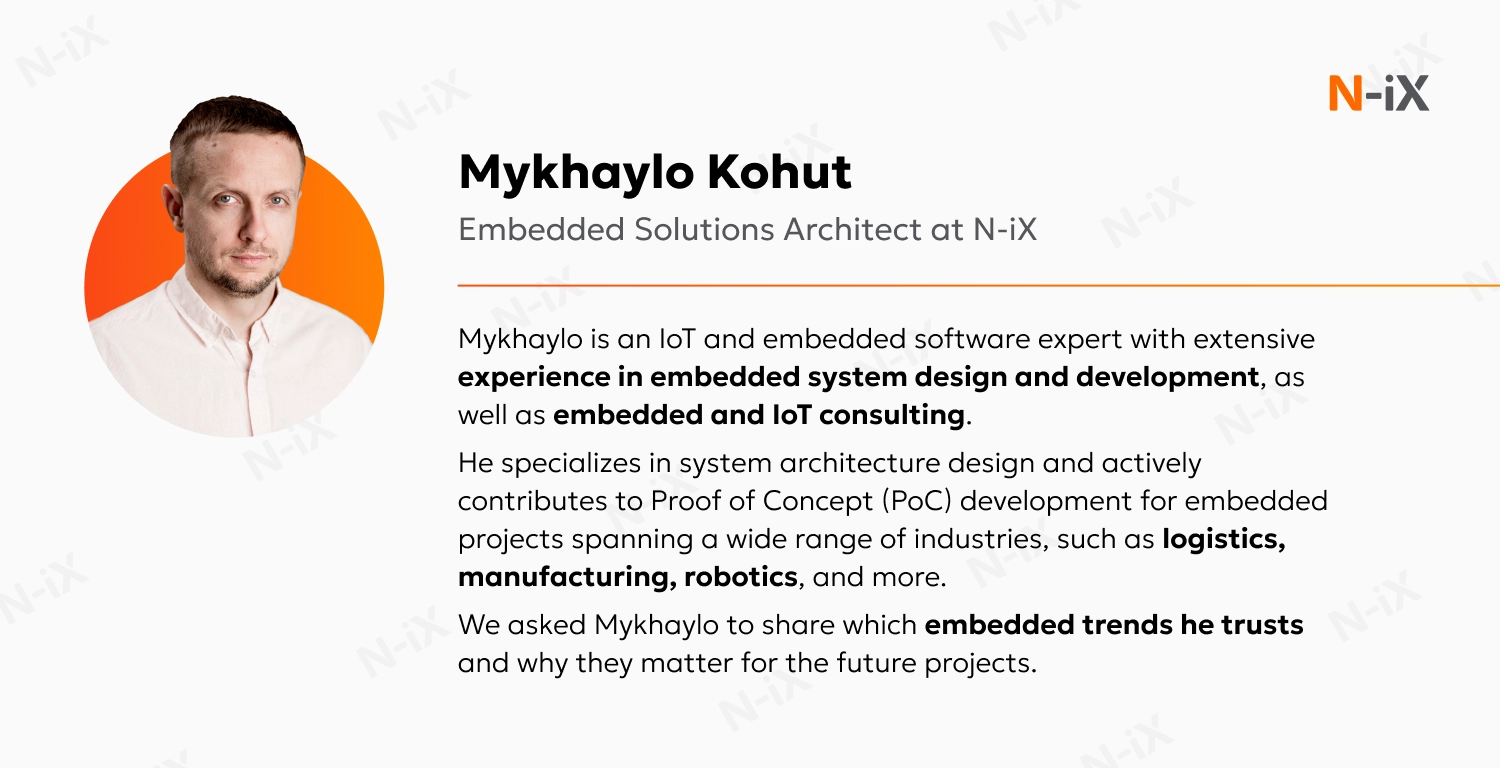
KS: What was the most memorable trend in embedded development during your practice? How did it change the approach toward embedded engineering?
MK: The last time I remember a trend changing embedded development was the introduction of mesh networks. This is obvious from the expansion and rapid development of mesh-dependent solutions for smart homes, smart buildings, and smart factories.
Before mesh networks, the devices communicated peer-to-peer. Mesh allowed the design and implementation of a more complicated topology, increasing coverage area and allowing wireless networks in locations with physical obstacles (walls, machinery, etc.). These areas can now be served with flexible and cheaper communication, which opens many new business opportunities.
KS: What emerging trends in embedded systems can have the same game-changing effect?
MK: I think it would be AI. Specifically, moving the data processing closer to the edge. It can help solve many current dilemmas, such as high traffic costs, cloud dependency, etc.
KS: Are there any recent trends in embedded systems you're skeptical about?
MK: I'm skeptical about AI-generated embedded codes. It may work well if done from scratch. However, if we're talking about legacy base integration and building CI/CD pipelines, real human engineers with the knowledge of embedded development peculiarities are needed. AI can't do that as well as real software engineers. So far, at least.
KS: What would you like to see in embedded development that is not here yet but would be great to have?
MK: I'd like to see hardware manufacturers adopt unified standards and use common protocols. There are a few attempts in this direction, such as using Matter protocols. Matter is a royalty-free protocol from the Connectivity Standards Alliance (formerly Zigbee Alliance). Built on Thread or Wi-Fi and commissioned via BLE, it lets smart devices from different brands communicate with one another, eliminating many of today's IoT compatibility issues.
KS: What are your predictions for the embedded software trends we'll see soon?
MK: I see three big shifts ahead. First, AI-driven toolchains will increasingly auto-generate and test embedded software. Second, industry-wide standards will keep unifying the software stack, making devices easier to mix and match. Third, far more powerful yet energy-frugal MCUs, including energy-harvesting parts, will let us run serious edge workloads without draining batteries.
KS: What do you think makes N-iX a great tech partner to companies willing to explore trends in embedded system development?
MK: Trends don't appear in a vacuum. Rather, they are becoming popular because already established technologies or approaches can support them. We at N-iX have over 2,400 software engineers skilled in cloud solutions development, data analytics, enterprise platform, and RPA, AI, ML, MLOps, cybersecurity, IoT, computer vision, and more. This allows us to assess what would be needed for the new integration to work and bring the expected ROI.
Besides strong tech expertise, we have tech partnerships with AWS, Microsoft Azure, GCP, Wirepas, Nordic Semiconductor, Raspberry Pi, Arduino®, MathWorks, and others. Our experience with their products and tools will translate into faster project rollout and faster delivery to our clients. In addition, it usually means early access to new features and tools they develop.
For the past 15 years, we've been developing IoT and embedded systems for finance, manufacturing, logistics and supply chain, retail, telecom, automotive, healthcare, energy and utilities, and agritech. Our knowledge of the domains' specifics also means faster development and the right choice of technologies that would work for the niche.
One of our major strengths at N-iX is our ability to build an effective PoC quickly to test the idea and estimate the needs of a full-fledged embedded project. When it comes to embedded system development trends, it's better to double-check if they work than to double-pay if they don't.
KS: How would you recommend the businesses "to test the waters" before diving head-on into applying the latest trends in embedded systems?
MK: I'd recommend consulting with the embedded developers first. Sometimes there are a few ways to reach the same business goal, so they will help you choose the most optimal one for your environment, tech ecosystem, and requirements. It holds especially true if you have specific constraints, and with the embedded, it's almost always the issues with hardware or connectivity.
If you do decide to move on with adopting some trendy approach or technology, research if there are already results on how it's working and whether the trend lives up to its hype. You can also make a PoC to test your hypothesis on your specific case.
Also, consider how the trend adoption aligns with your further transformation plan and with the upcoming changes in industry regulations. For example, if you plan on adopting on-device AI or edge AI, it would probably be a good option to invest in low-energy MCUs that can support data processing at the edge in the future.
Final thoughts
Our research shows that embedded software trends influence how every smart product is designed, built, and supported. Following them is rewarding only when each new idea clearly maps onto your operational goals and ROI. This requires a tech partner who can translate market momentum into reliable, standards-compliant solutions that fit your exact operating environment.
With deep experience in embedded design, cloud integration, AI, ML, IoT, and more, N-iX turns what's trendy into what's working for your case. Contact us and let's discuss how we can strengthen your next embedded initiative from a quick proof of concept to a fully managed product launch.
Sources:
- State of IoT 2024: Number of connected IoT devices growing 13% to 18.8 billion globally | IoT Analytics
- Embedded Systems Market Size to worth USD 283.90B By 2034| Precedence Research
- Cyber Resilience Act 2024/2847 | EUR-Lex
- IDC Estimates Global Spending on Edge Computing to Grow at 13.8% Reaching Nearly $380 Billion by 2028 | IDC
Have a question?
Speak to an expert
